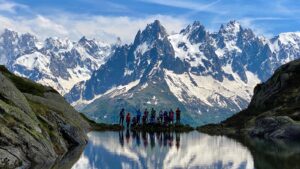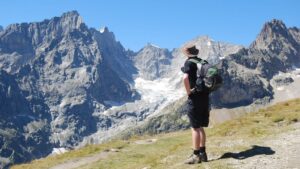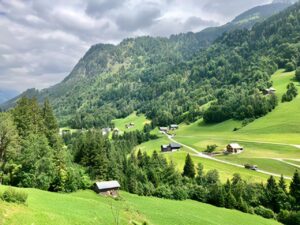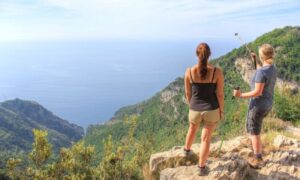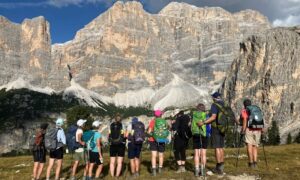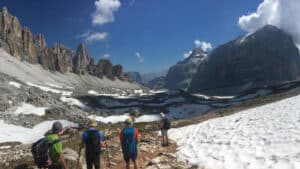Choose your trek
Select your trek and check availability, either by phoning us or sending an on-line enquiry.

The Jotunheimen National Park is a wilderness paradise in Norway, known for its towering peaks and dramatic landscapes. This trek takes you through a circular route, including highlights such as the iconic Besseggen Ridge, the emerald waters of Gjende Lake, and the serene Glitterheim Valley. The terrain is diverse, ranging from rocky trails to lush valleys, with opportunities to encounter reindeer and alpine flora. Nights are spent in cosy mountain huts, blending rustic charm with modern amenities. This challenging trek promises unparalleled natural beauty and a deep connection with Norway’s outdoor traditions.
Tough
A mix of Norwegian and international meals
Comfortable hotels and good mountain huts
Experienced International Mountain Leaders
Minimum 6 / Maximum 14 people
All scheduled treks will run with our minimum group size
Guided trek in the wilds of the Jotunheimen National Park.
Upon reaching our hotel in central Oslo you will have the opportunity to settle in and explore the city. The hotel is easily accessed from the airport by the airport express train to Oslo S (Oslo Central Station) in 20 minutes. It is 5 minutes walk from the station to the hotel.
This map is for illustrative purposes only.
The Jotunheimen Trek covers approximately 115km/71 miles and is a challenging route with significant ascents and descents. This trek is ideal for experienced walkers who are comfortable hiking 15-20km (9-12 miles) per day and tackling varied terrain, including steep climbs and descents. Each day typically involves 6-8 hours of walking, with some days extending to 8-9 hours outdoors. While much of the trek follows well-maintained trails, there are sections with rocky, uneven paths and areas where the ground may be loose underfoot. Certain parts of the route include stream crossings, where there is a possibility of wet feet. This trek demands good physical fitness and a sense of adventure, rewarding participants with breathtaking views and an unforgettable wilderness experience.
The Jotunheimen Trek is a challenging adventure suited for fit hikers with prior experience in multi-day mountain treks. Typical days include:
The Jotunheimen Trek is comparable in technical difficulty to the TMB and the Dolomites treks that we run, but you have to carry your own gear for the duration. There are some long days with consistent ascent/ descent. Accommodation is in remote mountain huts where you only have what you carry in your back-pack. The huts, however, are regarded as the best in Europe and are very comfortable. There are no luggage transfers on this trip: with careful packing you can keep the weight of your backpack to a minimum. You are able to wash your clothes by hand and use the drying rooms at the huts.
The terrain is not technical but can be steep, rocky, and uneven in places. Good quality hiking boots are essential for this trek.
The Jotunheimen Trek is a challenging trek designed for fit and experienced hikers who are accustomed to multi-day mountain trekking. Typical days are quite long, but no more so than other treks we run, such as teh TMB. The difference is that you need to carry your own gear for the week.
Days typically involve 6-7 hours of hiking, covering 12-20km per day, with ascents and descents ranging from 800-1200m. The route traverses through varied terrain such as well-trodden trails, rocky and uneven paths, and faint tracks. You will need a high level of fitness and confidence when hiking.
Although we hope the weather will be kind, it can be unpredictable, with strong winds and cold rain being possible, adding to the physical challenge.
In addition to the trek cost, you should budget for the following extra expenses:
Credit cards are widely accepted throughout Norway. However, cash is preferred for small purchases in the mountain huts. We recommend carrying about NOK 1,000-1,500 in cash for snacks, drinks, and other minor expenses. ATMs are available in Oslo and Beitostølen.
Hotels (3 nights)
Mountain Huts (7 nights)
Meals
Our Jotunheimen Trek accommodates a maximum of 14 participants, with most groups averaging 8-12 people. This small group size ensures:
The minimum group size is 6 participants. In the rare event that the minimum is not reached, we will offer to transfer you to an alternative date or provide a full refund.
Arrival and departure transfers in Oslo
Local transfers
If your flight is delayed and it means you don't make it to the hotel on day 1, you should call us for information on how to get to the start of the trek on day 2. Any costs incurred will be your responsibility. Please note that it is 4-4.5 hours by road to Gjendesheim: there are daily buses. A taxi will be expensive.
Flying into Oslo is straightforward, with regular connections from many European and international hubs. We meet at the hotel in central Oslo.
The transfer to Gjendesheim Mountain Hut starts early on Day 2, and takes approximately 4 hours.
If you miss the group transfer, you'll need to arrange your own transportation to Gjendesheim at your expense.
Departure: On Day 11, you need to get back the airport for your flight.
Extending your stay in NorwayYou might wish to extend your stay to explore Oslo with iconic landmarks such as the Oslo Opera House, Vigeland Sculpture Park, or the Viking Ship Museum. Accommodation can be booked through websites like booking.com for competitive rates. Oslo also serves as an excellent gateway for further travel to destinations throughout Norway, Scandinavia and Northern Europe.
It is your responsibility to verify your specific passport, visa, and entry requirements to ensure you have the necessary documents for the trek. Regulations can change, so review the rules before you travel.
Comprehensive travel insurance is mandatory for all our treks. Your policy should cover::
Please carry a copy of your insurance policy, including emergency contact numbers, with you during the trek. It is also advisable to leave a copy with someone back home.
The summer hiking season in Jotunheimen runs from July through to early-September. During this time, weather conditions are generally favourable for trekking, with long daylight hours and mild temperatures. However, mountain weather can be unpredictable, and trekkers should be prepared for sudden changes, including rain and wind.
Temperature: Expect daytime highs of 15-20°C (59-68°F) in the valleys and 5-10°C (41-50°F) at higher elevations. Night temperatures can drop to 0-5°C (32-41°F), feeling colder in exposed areas.
It's essential to come equipped for varying mountain weather with layered clothing, allowing you to adjust to conditions throughout the day.
Your guide will monitor the weather daily to ensure safety and maximum enjoyment of the trek.
Select your trek and check availability, either by phoning us or sending an on-line enquiry.
Complete an on-line booking form and pay a deposit of 20% of the tour.
Payments are in British Pounds (GBP). You can pay by bank transfer, credit or debit card.
Once the payment has been received we will send you an e-mail confirmation.
Salamander Adventures has over 30 years experience running adventure holidays throughout the world. Key staff have worked for Exodus, Explore and Trailfinders.
Lorem ipsum dolor sit amet, consectetur adipiscing elit. Integer auctor, velit vel suscipit sollicitudin, eros turpis efficitur odio.
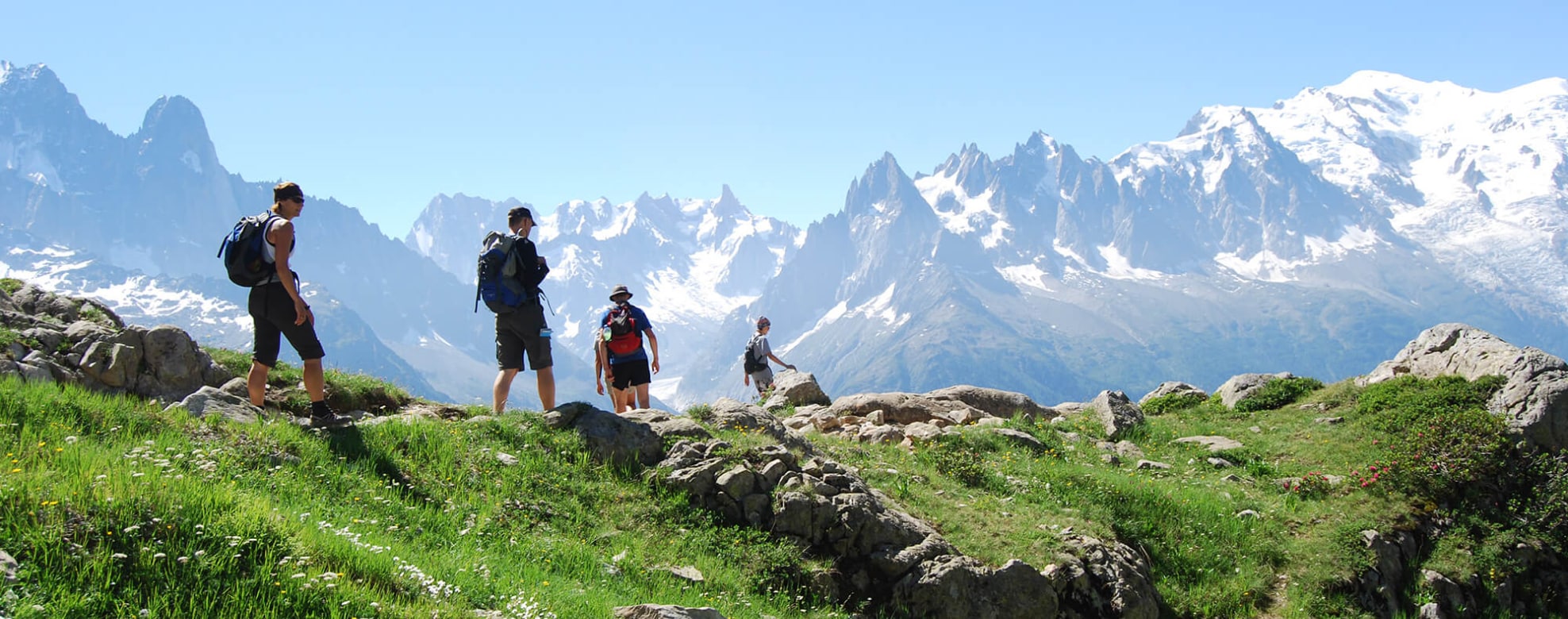
Immerse yourself in the stunning wilderness and Nordic traditions of Norway’s Jotunheimen National Park on this unforgettable mountain trek.
View All Points of InterestA Journey into Wilderness: Jotunheimen National Park Discovering Jotunheimen’s Natural Majesty Jotunheimen National Park, known as the "Home of the Giants," is a standout highlight on Salamander Adventures’ Jotunheimen Trek.…
Learn moreA Journey Through Norway's Scenic Besseggen Ridge Main Attraction: The Jewel of Jotunheimen National Park Besseggen Ridge, a highlight of Jotunheimen National Park, is a spectacular geographical feature that attracts…
Learn moreA Journey to Gjende Lake: A Salamander Adventures Highlight Encountering the Scenic Majesty of Gjende Lake Nestled in the heart of Norway’s Jotunheimen National Park, Gjende Lake stands as a…
Learn moreA Natural Gem in Jotunheimen: Leirvassbu Valley Discovering the Heart of Leirvassbu Valley Nestled within Norway’s Jotunheimen National Park, Leirvassbu Valley is a geographical feature of striking natural beauty and…
Learn moreDiscover the Majesty of Galdhøpiggen At 2,469 metres, Galdhøpiggen is the crown jewel of Norway's Jotunheimen National Park and the highest mountain in Scandinavia. Known for its awe-inspiring glacial landscapes…
Learn moreReady to explore the world’s most stunning landscapes? Reserve your spot today!

Common questions from Jotunheimen trekkers:
The Jotunheimen Trek demands excellent physical fitness and endurance to hike 12-18km per day for up to 7 consecutive days. The route includes rugged trails with steep ascents and descents, requiring trekkers to maintain a steady pace across uneven terrain. Strong legs, a robust cardiovascular system, and a resilient mindset are essential for enjoying this challenging adventure.
This trek is rated 5 out of 5 (Hard), designed for experienced hikers seeking a demanding experience. Expect to hike for 6-8 hours daily, with significant elevation changes and minimal rest opportunities. The terrain includes rocky ridges, alpine meadows, and glacial streams, offering a mix of rewarding challenges and breathtaking scenery.
To prepare, focus on building aerobic fitness and leg strength. Engage in regular hiking, running, cycling, or other cardiovascular activities. Incorporate training on hilly or mountainous trails with a weighted pack to simulate the trekking conditions. Aim to complete several full-day hikes (15+km, 1000+m elevation gain) on consecutive days to prepare your body for sustained effort.
The more trekking-specific preparation you do, the more enjoyable the experience will be, allowing you to focus on the spectacular landscapes rather than the physical exertion. A positive attitude, mental resilience, and a love for adventure are just as important as physical fitness. The Jotunheimen Trek offers the incredible reward of exploring Norway’s rugged wilderness and experiencing its stunning natural beauty firsthand.
The Jotunheimen Trek takes you through Norway’s dramatic and pristine landscapes, featuring well-established trails designed for trekkers. These trails are suitable for experienced hikers but present some challenging terrain in parts.
Trail surfaces Expect a variety of surfaces underfoot:
No technical climbing is required, but there are some exposed sections with steep drop-offs. Trekking poles are highly recommended for balance and reducing strain on knees.
Elevation The Jotunheimen Trek features significant elevation gain and loss on most days. The trails include:
While the climbs are demanding, they are achievable with a steady pace and regular breaks. The stunning views at the top make every effort worthwhile.
Water crossings Several streams and rivers are encountered on the trek:
Water crossings are generally safe and manageable. After heavy rains, levels may rise temporarily, but guides ensure all crossings are safe, providing assistance as needed. Quick-drying footwear is helpful for maintaining comfort.
Trail hazards As with any mountain trek, the Jotunheimen terrain includes potential challenges:
Your guide will provide tips on navigating these hazards safely, ensuring a rewarding and enjoyable experience. With the right preparation and a sense of adventure, the terrain of Jotunheimen will be one of the highlights of the trek.
For an authentic Norwegian trekking experience, the Jotunheimen Trek includes several nights in remote mountain huts. Staying in these rustic accommodations allows you to fully immerse yourself in the stunning wilderness without the burden of carrying heavy camping gear.
While the huts are comfortable, they are simpler compared to hotels. Here’s what to expect in terms of sleeping arrangements and bathrooms:
Staying in the huts offers a unique sense of camaraderie and a chance to share the experience with fellow hikers. Evenings in the huts are spent enjoying hearty Nordic dinners, swapping trail stories, and marvelling at the stunning mountain views. While the setup is simple, the connection to nature and the social atmosphere more than compensate for the lack of luxury.
Embrace the adventure and the shared experience of the huts—it’s all part of what makes trekking in Jotunheimen so memorable!
Staying connected during the Jotunheimen Trek can be a challenge due to the remoteness of the national park and the rugged terrain. However, with some advance preparation, you can still check in with family and friends at certain points along the trek. Here’s an overview of your communication options:
If you plan to use your phone, ensure your plan includes international roaming with data. Charges can add up, so consider purchasing a prepaid Norwegian SIM card for better rates. You’ll need an unlocked phone that accepts international SIM cards.
When WiFi is available, use it to check in, share photos, or make a quick video call. However, try not to rely too heavily on technology—use this time to disconnect and enjoy the natural beauty around you.
While these devices can be costly, they provide peace of mind for those who need reliable communication in remote areas.
Before starting your trek, establish a communication protocol with family or friends. Share your itinerary, trek dates, and realistic expectations about when you’ll be able to check in. Given the limited cell and WiFi coverage, it’s best to plan on updating loved ones every few days when you’re in a village or hotel. Reassure them that no news is good news during the trek.
Your guide will carry a satellite phone or similar device for emergencies, and Salamander Adventures monitors each group’s progress. Should anything unexpected occur, we can quickly contact your emergency contacts.
Remember, one of the greatest joys of the Jotunheimen Trek is unplugging from daily life and immersing yourself in nature. Trust your guide, embrace the moment, and enjoy the serenity of Norway’s pristine wilderness. The rest of the world can wait!
Packing for the Jotunheimen Trek requires a balance between being prepared for the unpredictable Norwegian weather and keeping your load manageable. You’ll benefit from layers and lightweight gear to ensure comfort and safety. Here’s a recommended packing list:
Remember, luggage transfers are provided on 6 out of 10 trekking days, so you won’t need to carry all your gear every day. Bring essential items for refuge nights, but keep the load light for comfort on the trails.
Finally, break in your boots and test your pack during training hikes. Comfortable, well-fitted gear will make your Jotunheimen adventure even more enjoyable, allowing you to fully immerse yourself in Norway’s stunning landscapes.
